This street, which runs along the inside if the city walls (1329), once housed five nunneries, including Sant’ Anna which has its own page.
Santa Maria del Popolo (1291)
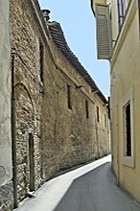
Sant’ Elisabetta (1230)
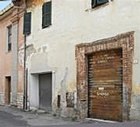
The nunnery was suppressed in the Napoleonic era, when some of the nuns moved to Santa Maria di Betlem (below) and others to Santa Maria della Croce.]
The complex became the seat of the Conservatorio delle Convertite di Santa Margherita (which has since caused confusion between this complex and that of Sant’ Antonio delle Margaritole , below). Its dedication changed again to that of San Michele Arcangelo, when the complex passed to the Orfanotrofio Maschile di Foligno.
The following detached frescoes are now in the Pinacoteca Civica:
Scenes from the Passion (late 14th century)
These frescoes, which are attributed to the Maestro dell' Abside Destra di San Francesco di Montefalco, were discovered in 1909 during the demolition of part of the ex-nunnery (which was then known as Santa Margherita). They depict:
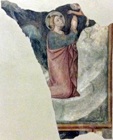
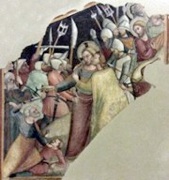

-
✴Christ in the garden (1);
-
✴the capture of Christ, in which Judas kisses Christ as He warns Peter not to throttle one of His captors (2);
-
✴the way to Calvary (3) of which only the upper part survives;
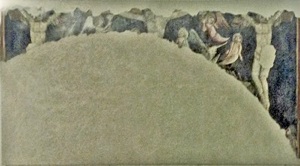
-
✴the Crucifixion of Christ and the two robbers (4), of which only the upper part survives;
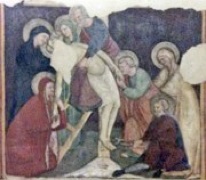
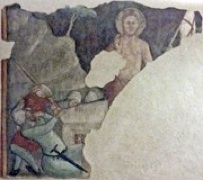
-
✴the Deposition ; and
-
✴the Resurrection.
Fresco fragments (late 14th century)
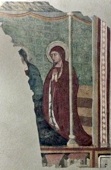
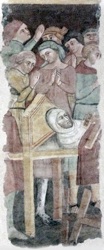

Three fragments were found in 1910 in the ex-nunnery. Like those above, they too are attributed to the Maestro dell' Abside Destra di San Francesco di Montefalco. According to Emanuela Cecconelli (referenced below, at p. 378), they depicted;
-
✴Christ in the house of Mary and Martha;
-
✴a scene from the legend of the verification of the True Cross in which the relic restored a dead person to life; and
-
✴a scene from the life of St Elizabeth of Hungary, in which she distributes out what seem to be small scrolls to a number of young women.
St Augustine (early 16th century)
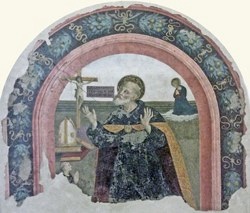
This detached fresco in the Pinacoteca, which depicts St Augustine in prayer before a crucifix, with a kneeling monk, presumably the donor, is attributed to Lattanzio di Nicolò.
Sant’ Agnese (ca. 1382)
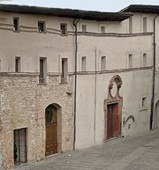
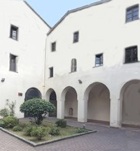
This Franciscan nunnery was first documented in 1382 in a legal document that was signed:
-
“ante portam monasterii Margariture Margarita Puccipti custorixdicti monasteri quietavit.”
It was presumably known as the Margaritole because Margarita Puccipti had been its founder. In 1394, Marianus Puccipti made a will in which he made two bequests to the the monastery called "delle contesse o vero de frate Pauluccio" (i.e. to the nunnery of Sant’ Anna, opposite) and third “allo locho de Margaritura”.
The dedication of the church changed from that of Sant’Agnese to that of St Antony of Padua in the 16th or 17th century.
This community was suppressed in 1801, when some of the nuns chose to move to Sant’ Anna while others moved to San Claudio. The ex-church was used for the first Pinocoteca of Foligno from ca. 1870.
Scenes from the Life of St Antony of Padua(17th century)
These frescoes, which were apparently signed by Ascensidonio Spacca, il Fantino, were documented in 1872 on the wall behind the high altar of the church of Sant’ Antonio. Traces survive in the deconsecrated church.
Santa Maria di Betlem
The buildings at number 27-33 on the left originally formed part of the nunnery of Santa Maria di Betlem.
In 1379, a religious woman called Morbida di Gennaro da Montecchio rented a small house in Via dei Monasteri for herself and two companions. The sisters, who were known as the "Povere donne di Morbida della penitenza", lived under episcopal authority but followed no recognised rule.
The sisters faced continual pressure to accept the status of nuns and, after the death of Morbida in 1404, they succumbed. Bishop Federico Frezzi placed them under the authority of the Abbot of Santa Maria in Campis, a monastery that belonged to the Cistercian congregation of Corpus Christi. This was the only female community that was ever accepted by the congregation. In 1435, at the request of the Abbess Stefanuccia di Matteo, Bishop Giacomo Elmi definitively exempted the nuns from episcopal jurisdiction.
In 1582, the monastery of Santa Maria in Campis passed to the Olivetans. It is likely that the nuns made this change at the same time, albeit that the earliest surviving reference to an Olivetan nunnery here dates to 1718.
The nunnery was suppressed in the Napoleonic era. It was re-opened early in the 19th century, when it merged with two Augustinian nunneries:
-
✴Sant’ Elisabetta (above); and
By 1820, it was largely an Augustinian institution, albeit that four of the nuns still belonged to the Olivetan Congregation.
The community was suppressed and the church was closed in 1862. The nuns re-formed as an Augustinian community at Palazzo Pierantoni ( 23, Via Pierantoni) in 1879 and moved to a new nunnery near Sant' Eraclio in 1981.
Chiesa di Santa Maria di Betlem
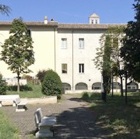
Chiesa del Corpo di Christo

The church was de-consecrated in 1862. It was badly damaged in the earthquake of 1979. It re-opened in 2003 after a major restoration and is now used for exhibitions. (Ring 0742 330580 to arrange a visit).
Exterior
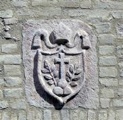
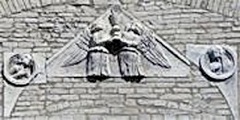
There are two interesting coats of arms on the facade:
-
✴those above the closed door to the right of the main entrance belong to the Olivetans; and
-
✴those above the main portal, which depict two angels holding a Eucharistic chalice, belong to the Congregation of Corpus Christi. They are mounted between tondi containing busts of the figures of the Annunciation.
Interior
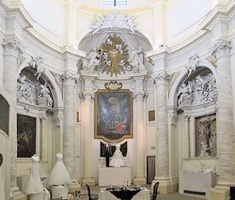
Sister Maria Cecilia Roncalli financed the new high altar in 1736.
Communion of the Apostles (ca. 1737)
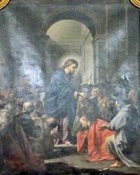
Read more:
E. Cecconelli, “Ascensidonio Spacca a Foligno: Sulle Tracce di due Opere dell' Artista Bevanate”, Bollettino Storico della Città di Foligno, 37 (2014) 361-98
P. Guerrini and F. Latini, “Foligno: Dal Municipium Romano alla Civitas Medievale: Archeologia e Storia di una Città Umbra”, (2012) Spoleto
M. Sensi, “I Monasteri e Bizzocaggi dell’ Osservanza Francescana nel Secolo XV a Foligno”, in:
A. Horowski (Ed.), “All’ Ombra della Chiara Luce”, (2005) Rome, pp 87-175
Return to the page on Monuments of Foligno
Return to Other Nunneries in Foligno
Return to Walk I



